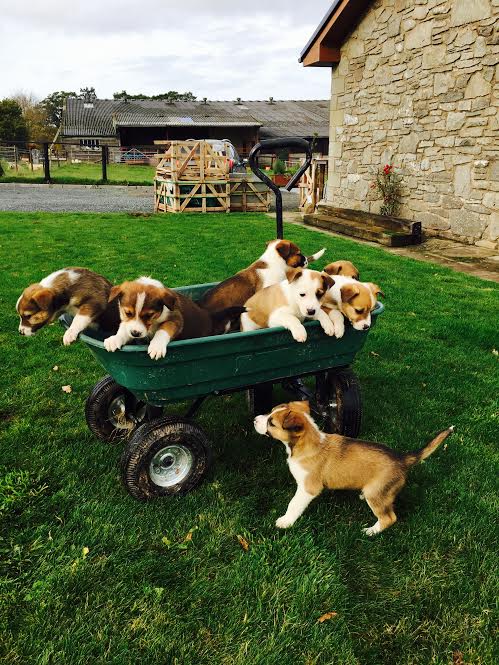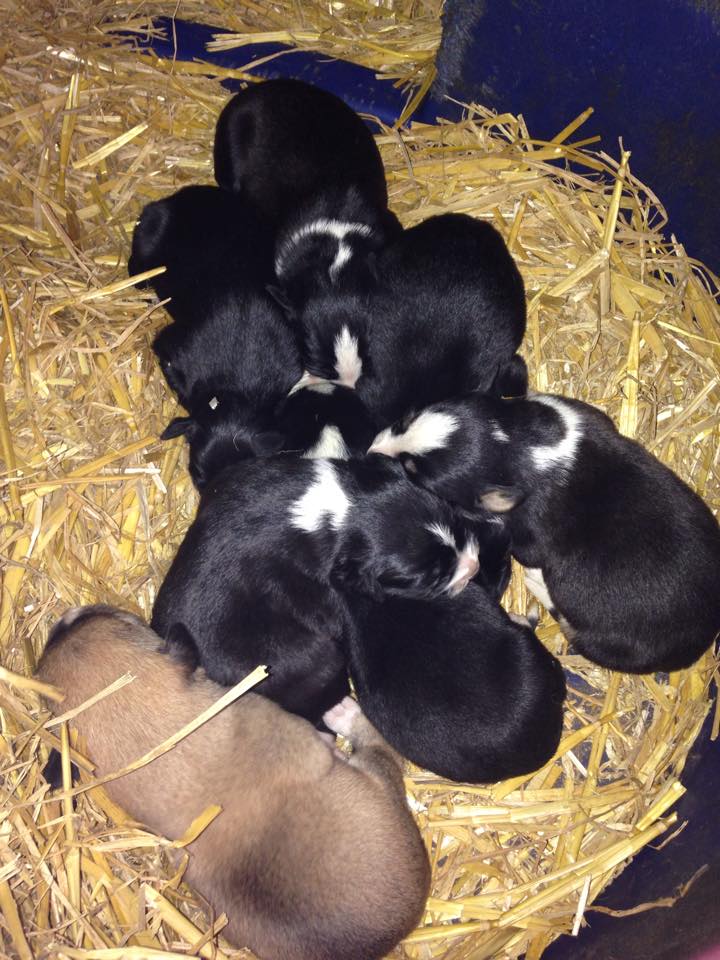Following on from yesterday.
In yesterday’s post I included the full documentary that was recently broadcast by the BBC. It was really interesting and a great insight into the uniqueness of the Welsh Sheepdog. More of that in a moment but first some details about Kate. As WikiPedia puts it:
Katherine “Kate” Humble (born 12 December 1968) is an English television presenter, mainly for the BBC, specialising in wildlife and science programmes. She was also the President of the RSPB until 2013.
Inevitably, Kate has her own website where one reads on the ‘home’ page:
Kate Humble and her sheepdog Teg set off to learn about the threats to British herding dogs. Filmed over a year, and with an exclusive insight into Kate’s shepherding life, ‘Kate Humble: My Sheepdog and Me’, unveils the story of the Welsh Sheepdog, explores the challenges of breed recognition and celebrates the simple joy of a handful of puppies.
‘Kate Humble: My Sheepdog and Me’ will be on BBC 2 on the 15th August 2016 at 9pm.
As changing farming practices, cross breeding and dog shows came about, so too did the decline of Britain’s working dogs. Of 22 British herding dog breeds, 12 are now extinct and the 10 remaining are mostly show dogs or pets. Kate sets out to discover if Teg belongs to one of these rare breeds, criss-crossing Wales as she uncovers the story of the Welsh Sheepdog and tries to find a mate for Teg.
From sheepdog trials to droving, from DNA profiling to a nationwide search for a mate, Kate and Teg’s journey is a celebration of the Welsh landscape and rural traditions. It also delves into the hi-tech, hi-value world of breeding rare dogs, and explores the timeless bond between humans and their dogs.
Join Kate and Teg as they play their part in the continuing survival of Britain’s herding dogs.
Now we hear a great deal about this endangered animal and that endangered animal but British herding dog breeds wouldn’t for me come to mind as one such endangered breed.
Clearly the effort to save the future of the Welsh sheepdog is significant underpinned by the fact that there is a society devoted exclusively to the breed: The Welsh Sheepdog Society. The website of the Welsh Sheepdog Society also has a page where registered sheepdogs are for sale. I’m going to republish the details on that page not only to show readers what the dogs look like but also to promote them to a wider audience.
ooOOoo
FOR SALE
Registered Welsh Sheepdogs of Sale from Society Members
Red and white welsh sheepdog pups for sale, pictured below. 6 bitches and 2 dogs by Fferm Mynydd Morgan out of Safn y Coed Erin. Both parents good workers. Ready to go now. Contact Edward Hopkins phone 07867 474 866.

Welsh sheepdog pups for sale. Black and white and red and white. By Wilden Gel out of Fron Felen Fflei. Good working stock. Contact Bob Williams 01745 550 304.
Welsh sheepdog pups for sale. By Hendrerhys Gelert out of Fron Felen Nel. Both parents good workers. Contact John Williams 01745 5870 657.
Welsh sheepdog pups for sale, picture below, ready December. Sire Ty Llwyd Bonnie trophy winner Penlanlwyd Tango. Dam Glyngwilym Rose. Contact Simon and Emma Mogford, 07846 017 669
Here’s hoping they all find wonderful loving homes.
Let me finish off today’s post by extensively quoting from the WikiPedia page about the Welsh Sheepdog.
The Welsh sheepdog (Welsh: ci defaid Cymreig, pronounced [kiː dɛˈvaɪd kəmˈrɛɨɡ]) is a landrace of herding dog from Wales.
Like other types of working dog, Welsh sheepdogs are normally bred for their herding abilities rather than appearance, and so they are generally somewhat variable in build, colour and size. Welsh sheepdogs are of collietype, usually black-and-white, red-and-white or tricolour, and merle markings may occur over any of these combinations. The coat may be short or fairly long, and the ears are pricked, but usually folded at the tip. They are longer in leg, broader in chest and wider in muzzle than the Border Collie. They are extremely active and intelligent, and therefore need much exercise and mental stimulation, if they are to be kept as pets. Welsh sheepdogs are more commonly known as Welsh collies, however these are the same breed.
Over many decades the Welsh sheepdog has largely been replaced for working sheep in Wales by the Border Collie, a standardised breed. However, in more recent years, efforts have been made to maintain the indigenous Welsh sheepdog as a distinct variety.
Welsh sheepdogs are usually of loose-eyed action, not fixing the stock with their gaze like the strong-eyedBorder Collie. They are able to work independently without necessarily being under direct human control. Welsh sheepdogs are most often used for herding sheep, but also readily work cattle, goats, and even horses and pigs. Traditionally they were often used as droving dogs to take cattle and sheep to markets locally or elsewhere in Britain.
The Welsh sheepdog’s life span is 12–15 years.
History
At one time there existed many sheep-herding dogs peculiar to Wales; during the 18th century Welsh drovers taking sheep for sale took with them five or six Welsh sheepdogs as “herders on the narrow roads, guards against highwaymen, and providers of game on the route”. These were an early type of Welsh sheepdog, higher on the leg and more racily built than the modern day breed.
However, by the 1940s the group had decreased to two or three breeds only. The ancient pure breeds of black-and-tan sheepdog and Welsh hillman were almost extinct, and were scarcely ever seen working. The type best known in Wales at that time was mostly descended from the old black-and-tan with an infusion of working Border Collie blood.
In the 1940s the Welsh sheepdog was still common throughout the north and central Welsh counties. In herding activities, it did not normally work low to the ground in “the showy manner sometimes seen in the work of the working [Border] Collies”, as British dog fancier C. L. B. Hubbard put it in 1948. It was variable in type; approximately 18 in (46 cm) in height, but the weight ranged from the lighter built, leggier dog of North Wales at 35 lb (16 kg) to the more solid 40 to 45 lb (18 to 20 kg) dogs of Glamorganshire and Monmouthshire. There were no dog show classes for the Welsh sheepdog as it was purely a working breed.
Finally another picture of Kate and Teg.


Perfect Match.. 🙂
LikeLike
Those puppies are rather cute as well! Maybe Jean and I should take on a few sheep! 😊
LikeLiked by 1 person
Haha.. well they would go nicely with everything else 🙂 a true small holding 🙂
LikeLike
Let’s face it, we’ve got nothing else to do here! 😄 In fact our neighbors Larry and Janell do have a few sheep that are pets.
LikeLiked by 1 person
🙂
LikeLike
Great article, and most illuminating, Paul. I’m going to watch Humble’s program now and learn more.
LikeLike
Thank you, Hariod. You will thoroughly enjoy it!
LikeLiked by 1 person
I would love to have one of these pups! Especially after we lost our beloved hounddog. But shipping one of these lovely pups to Hawaii would be exceedingly cruel, given the duration of the flight and the climate change. This breed is simply amazing – we have a friend who can often be seen with her five in her truck! Really special dogs.
LikeLike
Bela, Jean and I felt the same way. Would love to have one or two but out of the question in terms of bringing out to Oregon. Actually doubly out of the question for we are trying to scale down the number of animals around us (or at least not increase the numbers!).
Let me wish you a very lovely weekend.
LikeLiked by 1 person
And the same to you both, Paul ❤
LikeLike
Love this Paul! Thank you for sharing and spreading the word. 💛
LikeLike
Always a pleasure, especially encouraged by you!
LikeLiked by 1 person
I was anticipating watching another video. But alas I contented myself with reading about Kate and the Humble Farm. The farm had to cost a bundle to get it up to snuff in order to be a teaching farm and host scads of people. Lots of things going on there. I find the farm so interesting and quaint. Good things are happening on the farm.
The puppies, I hope, went to some wonderful homes. The Welsh Sheep Dog is a wonderful breed. I can visualize lots of people drooling about the breed after seeing the doc. I believe there are some breeders in the states but I could be wrong about that.
LikeLike
You’ve given me an idea. That is to see if there any registered Welsh Sheepdogs in the U.S. If so, might be nice to write up an article or two. Well done!
LikeLiked by 1 person
I had a look but didn’t find any. Might be under Welsh collie but did not type that in. Maybe you’ll have better luck. Perhaps in Canada there are some. It seems my memory is rather defective.
LikeLike
Ah! Join the club when it comes to defective memory! Or as I prefer to say, “I can remember everything, except the things I forget!”
LikeLiked by 1 person